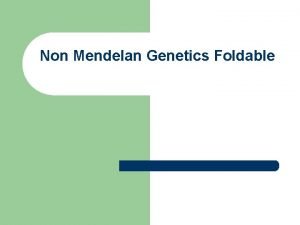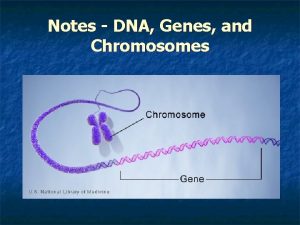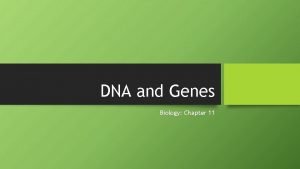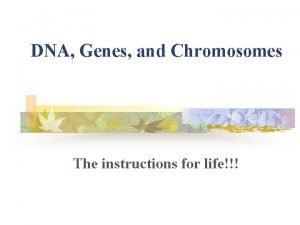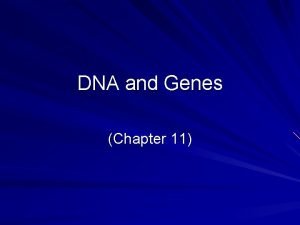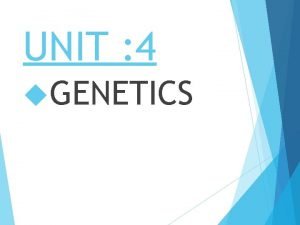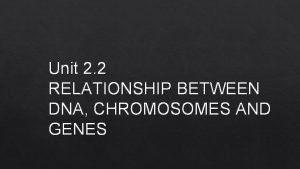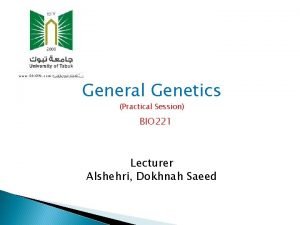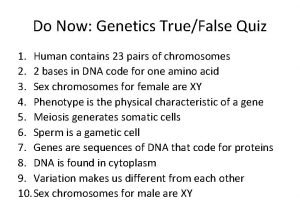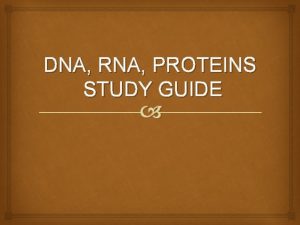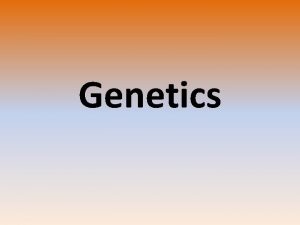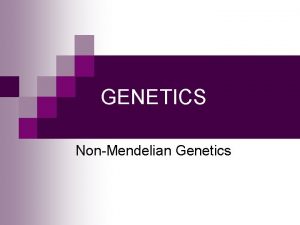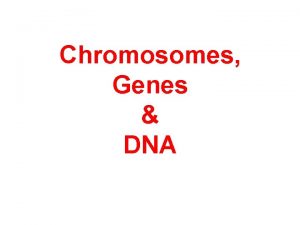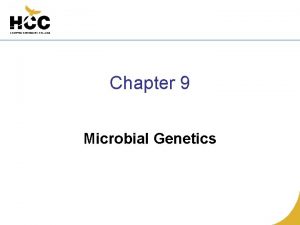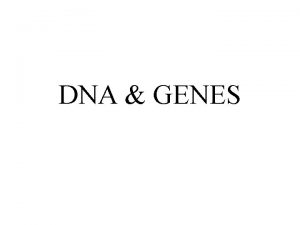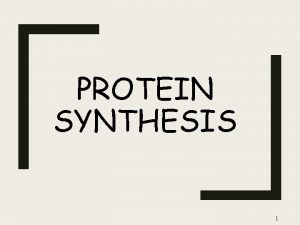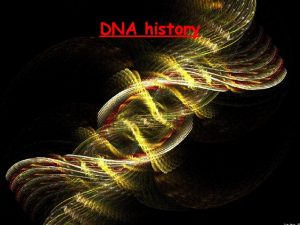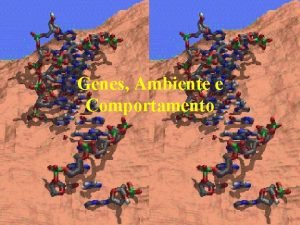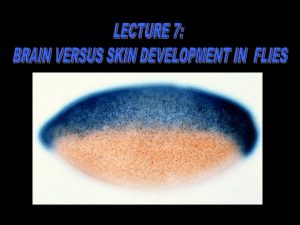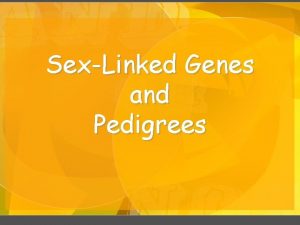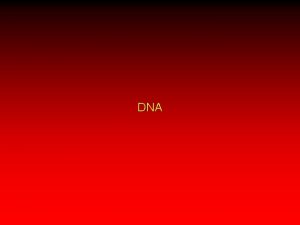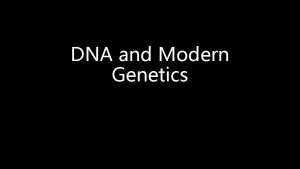DNA History Genetics is the study of genes








































- Slides: 40

DNA

History Genetics is the study of genes. Inheritance is how traits, or characteristics, are passed on from generation to generation. Chromosomes are made up of genes, which are made up of DNA. Genetic material (genes, chromosomes, DNA) is found inside the nucleus of a cell. Gregor Mendel is considered “The Father of Genetics"

History Rosalind Frankilin was the first person to discover DNA. But, Watson and Crick were given the Nobel Peace Prize for the discovery of DNA’s double helix.

DNA is often called the blueprint of life. In simple terms, DNA contains the instructions for making proteins within the cell.

Why do we study DNA? We study DNA for many reasons: its central importance to all life on Earth medical benefits such as cures for diseases better food crops.

Chromosomes and DNA Chromosomes are made up of genes. Genes are made up of a chemical called DNA.

The Nucleus DNA is located in the nucleus

The Shape of the Molecule DNA is a very long molecule. The basic shape is like a twisted ladder or a spiral staircase. This is called a double helix.

One Strand of DNA is made up of the following molecules: phosphate and deoxyribose (sugar), and bases. These fit together like puzzle pieces. phosphate deoxyribose bases

The Double Helix Molecule The DNA double helix has two strands twisted together. (In the rest of this unit we will look at the structure of one strand. )


Nucleotides O O -P O Nitrogenous base O C C O Phosphate C O Ribose (sugar) + phosphate + base= nucleotide. C C O Deoxyribose

The Basics Each side of the ladder is made up of nucleic acids. The backbone is a phosphate and a sugar The rung of the ladder is the nitrogen base.

Four nitrogenous bases DNA has four different bases: Cytosine Thymine Adenine Guanine C T A G

Types of nitrogen bases A= adenine G= guanine C= cytosine T= thymine

When making N hydrogen bonds, cytosine always O C pairs up with N guanine, N C And adenine always N pairs up with C N thymine. C (Adenine and C C thymine are shown N N here. ) O C C

Two Stranded DNA Remember, DNA has two strands that fit together something like a zipper. The teeth are the nitrogenous bases but why do they stick together?

Important Adenine and Thymine always join together A -- T • Cytosine and Guanine always join together C -- G •

RNA- Ribonucleic acid Single stranded!! In RNA Thymine is replaced by Uracil A-U (RNA) not A-T (DNA)

What’s the main difference between DNA and RNA

IF the DNA strand is GTACCAGATTAGC What would the RNA strand be?

Copying DNA Step 1 - DNA unwinds and unzips Step 2 - Once the molecule is separated it copies itself. The new strand of DNA has bases identical to the original

Transcription When a secretary transcribes a speech, the language remains the same. However, the form of the message changes from spoken to written

Transcription Transcription- RNA is made from a DNA template in the nucleus. This type of RNA is called messenger RNA or m. RNA

Transcription DNA is protected inside the nucleus. m. RNA carries the message of DNA into the cytoplasm to the ribosome's


Translation To translate English into Chinese requires an interpreter. Some person must recognize the worlds of one language and covert them into the other.

t. RNA Transfer RNA Happens in the ribosomes The cells interpreter (transfer RNA) t. RNA translated the three -letter codons of m. RNA to the amino acids that make up protein.

Translation Genetic translation converts nucleic acid language into amino acid language.

Codon The flow of information from gene to protein is based on codons. A codon is a threebase word that codes for one amino acid

The flow of information from gene to protein is based on codons.

Information Flow: DNA to RNA to Protein



Mutations A mutation occurs when there is a change in the order of the bases in an organism’s DNA. Mutations can happen due to physical or chemical agents called mutagens. Examples of mutagens: X-Rays, UV radiation, and chemicals

Mutations can be helpful, harmful, or have no effect at all.

3 types of Mutations Substitution Insertion Deletion

Substitution This happens when one base is substituted for another base. Example: Original DNA strand: AATGGAT Mutated Strand: AAGGGAT

Deletion This happens when one base it deleted from the original DNA strand. Example: Original DNA strand: AATGGAT Mutated Strand: AATGAT

Insertion This happens when a base is added to the original DNA strand. Example: Original DNA strand: AATGGAT Mutated Strand: AATTGGAT
 Linked genes and unlinked genes
Linked genes and unlinked genes Glomerulus
Glomerulus Polygenic inheritance
Polygenic inheritance Genetics foldable
Genetics foldable Genes chromosomes and dna
Genes chromosomes and dna Chapter 11 dna and genes
Chapter 11 dna and genes Dna, genes and chromosomes relationship
Dna, genes and chromosomes relationship Dna and genes chapter 11
Dna and genes chapter 11 Genes chromosomes dna
Genes chromosomes dna What is the relationship between dna chromosomes and genes
What is the relationship between dna chromosomes and genes What is agene
What is agene Dna genes
Dna genes Dna chromosomes genes diagram
Dna chromosomes genes diagram Dna rna protein synthesis homework #2 dna replication
Dna rna protein synthesis homework #2 dna replication Chapter 12 section 1 dna the genetic material
Chapter 12 section 1 dna the genetic material Genetics is the study of heredity and variation
Genetics is the study of heredity and variation Extending mendelian genetics
Extending mendelian genetics Replication
Replication Bioflix activity dna replication nucleotide pairing
Bioflix activity dna replication nucleotide pairing Coding dna and non coding dna
Coding dna and non coding dna What role does dna polymerase play in copying dna?
What role does dna polymerase play in copying dna? Dna rna and proteins study guide answers
Dna rna and proteins study guide answers Dna protein synthesis study guide answers
Dna protein synthesis study guide answers Hình ảnh bộ gõ cơ thể búng tay
Hình ảnh bộ gõ cơ thể búng tay Slidetodoc
Slidetodoc Bổ thể
Bổ thể Tỉ lệ cơ thể trẻ em
Tỉ lệ cơ thể trẻ em Chó sói
Chó sói Glasgow thang điểm
Glasgow thang điểm Chúa yêu trần thế
Chúa yêu trần thế Kể tên các môn thể thao
Kể tên các môn thể thao Thế nào là hệ số cao nhất
Thế nào là hệ số cao nhất Các châu lục và đại dương trên thế giới
Các châu lục và đại dương trên thế giới Công thức tính thế năng
Công thức tính thế năng Trời xanh đây là của chúng ta thể thơ
Trời xanh đây là của chúng ta thể thơ Cách giải mật thư tọa độ
Cách giải mật thư tọa độ Phép trừ bù
Phép trừ bù Phản ứng thế ankan
Phản ứng thế ankan Các châu lục và đại dương trên thế giới
Các châu lục và đại dương trên thế giới Thơ thất ngôn tứ tuyệt đường luật
Thơ thất ngôn tứ tuyệt đường luật Quá trình desamine hóa có thể tạo ra
Quá trình desamine hóa có thể tạo ra



